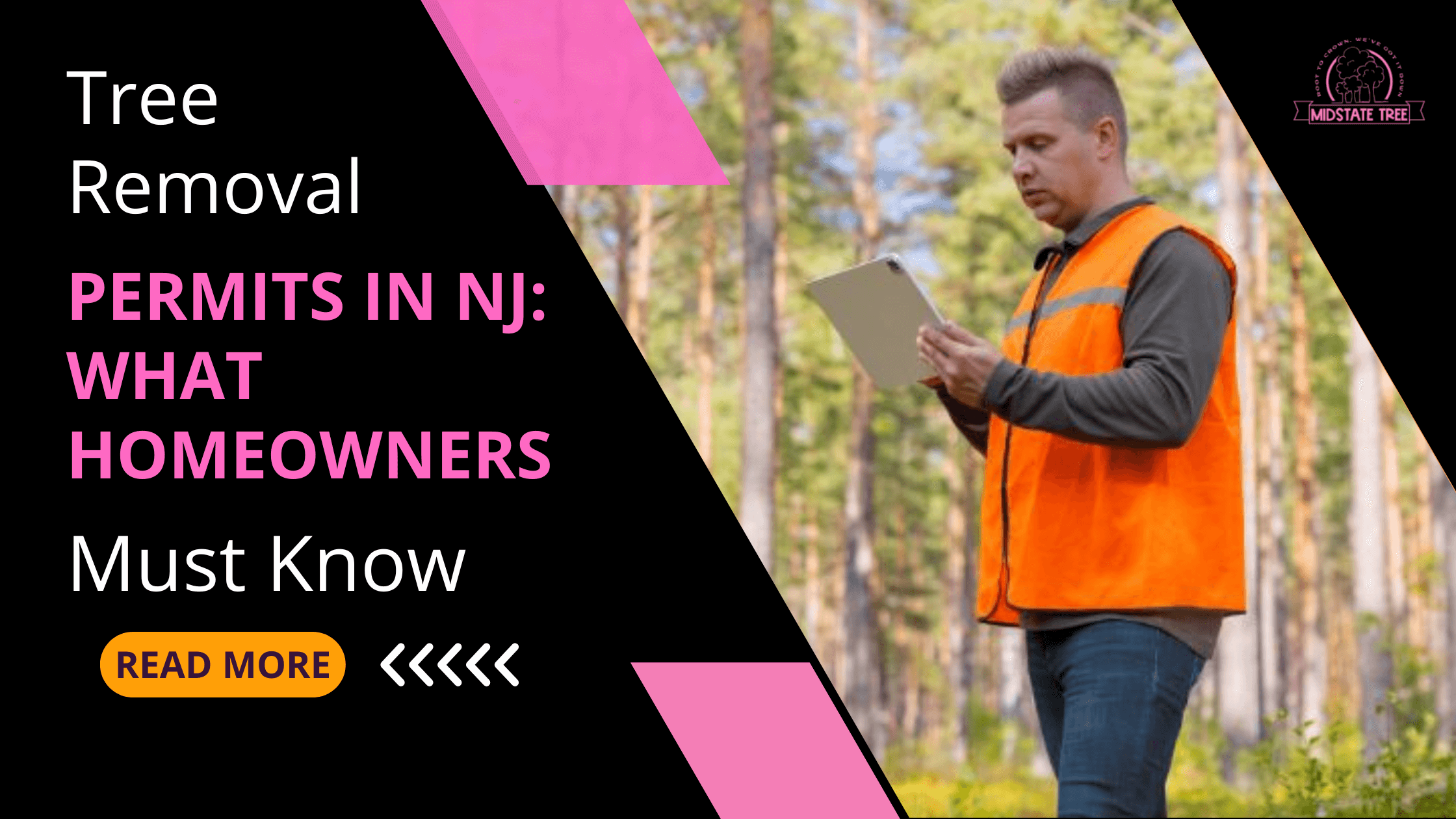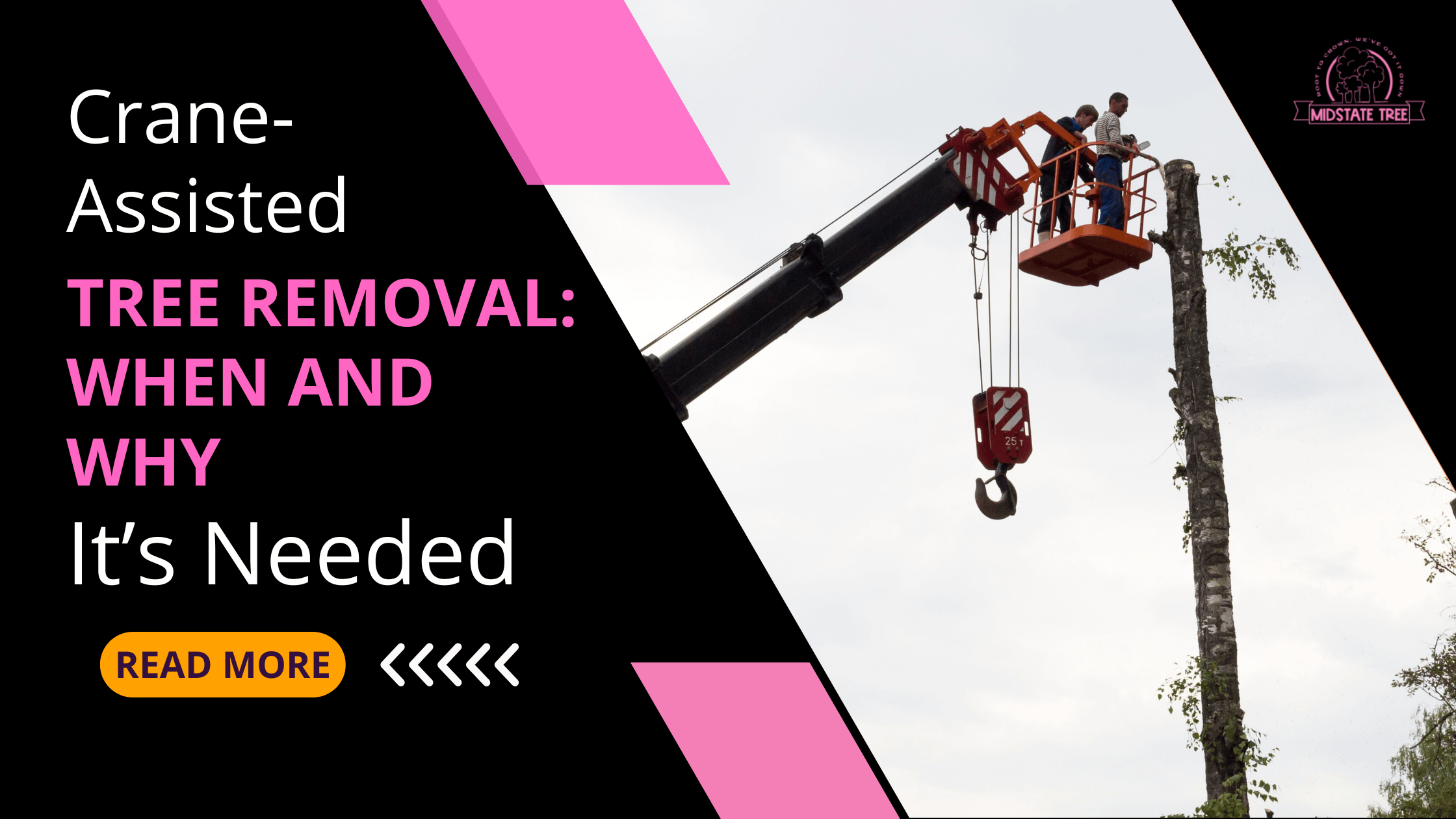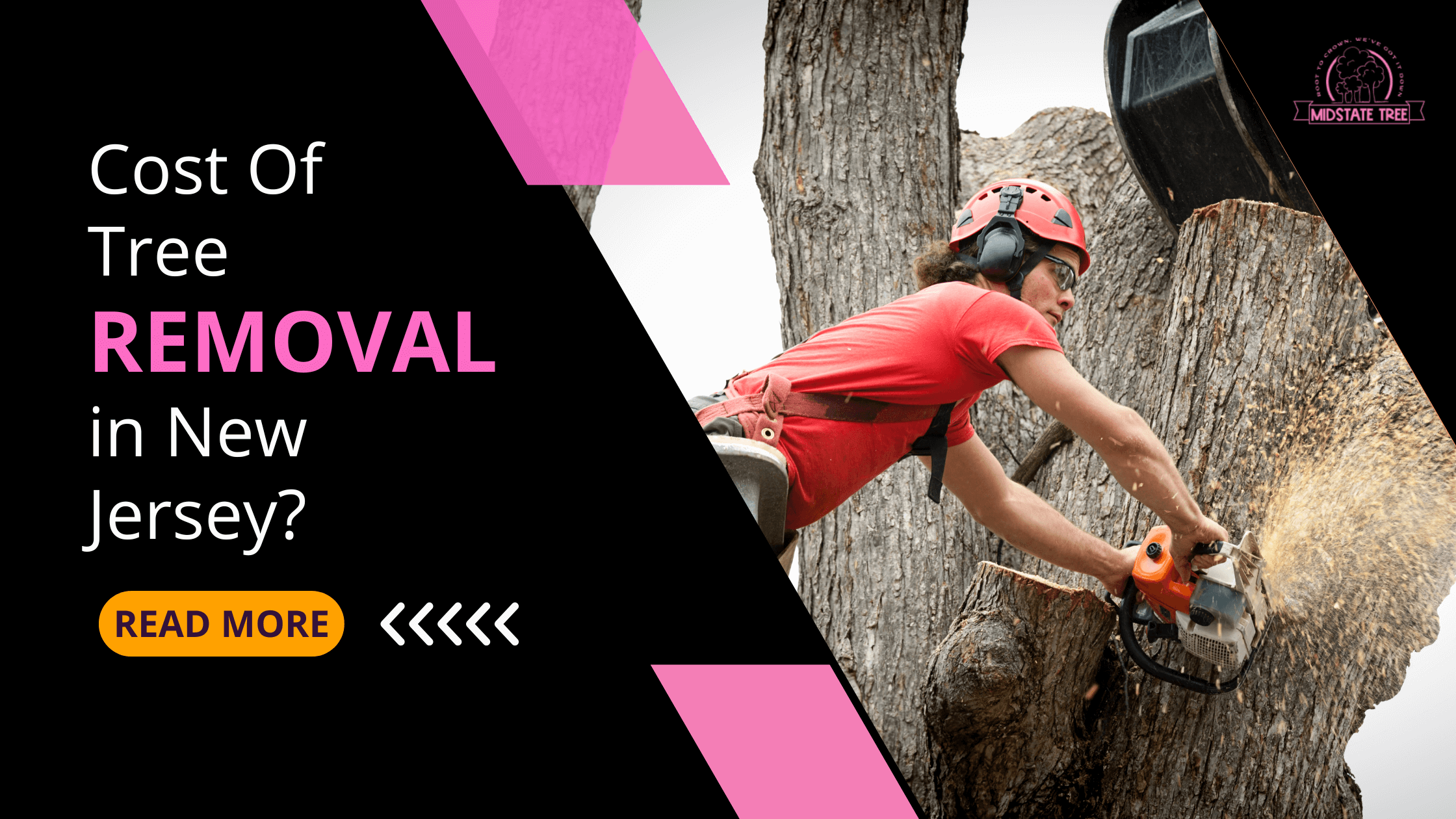If you have a massive tree leaning toward your house, a decaying oak too close to the power lines, or a tree in a tight backyard that traditional crews can’t reach, crane-assisted tree removal might be the safest and smartest option.
It’s used when large, unstable, or hard-to-access trees pose a serious risk to your home, your family, and your neighborhood. In places like suburban New Jersey—with hills, tight driveways, and narrow yards—cranes often make tree removal possible where no other method can.
Why Tree Removal Isn’t Always Simple
Cutting down a tree might sound easy—grab a chainsaw and go. But when you’re dealing with a 70-foot maple next to your roof or a rotting pine on a slope, it’s a whole different story.
Trees can weigh several tons and fall unpredictably, especially when they’re damaged, diseased, or structurally weak.
In crowded NJ neighborhoods with fences, garages, or patios just feet away, traditional removal methods can cause serious property damage—or worse, injury. That’s where a crane changes everything. It lets the crew lift and remove the tree piece by piece, without dropping anything.
What Is Crane-Assisted Tree Removal?
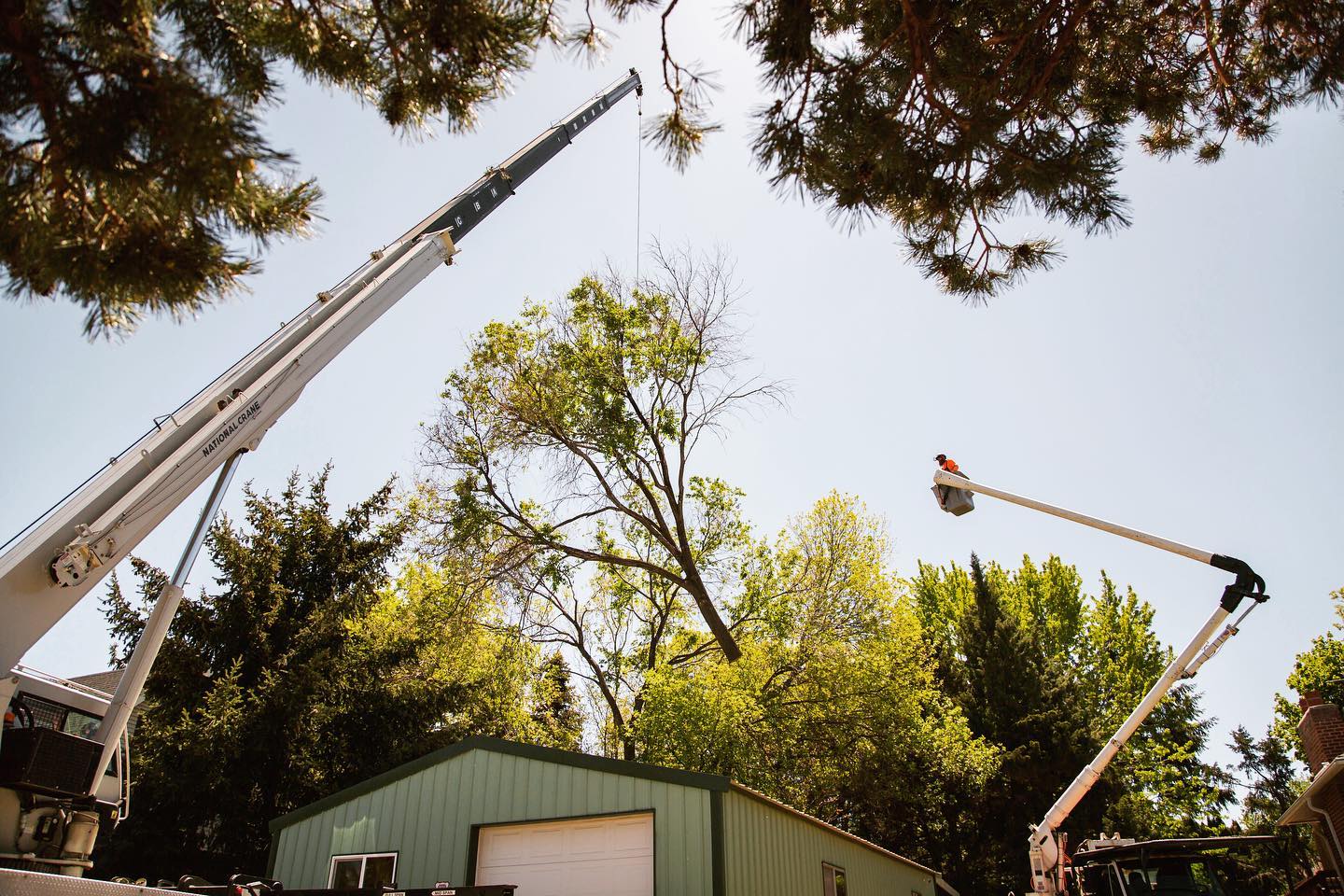
Crane-assisted tree removal is a specialized method of dismantling trees using heavy machinery—specifically, a hydraulic crane—when conventional techniques are unsafe, impractical, or too time-consuming.
This method isn’t just about power; it’s about precision and control. The crane works in tandem with a certified arborist who selects strategic “pick points” on the tree.
These points are where rigging slings or nylon straps are attached. Once secured, the arborist makes a clean cut, and the crane operator carefully lifts the segment into the air and swings it to a designated drop zone or landing area.
Cranes are particularly useful when:
Trees are over 70 feet tall and unstable.
There’s no safe felling direction.
The tree is located in a confined area (like between two homes or in a backyard with no access).
Structural hazards (power lines, sheds, pools) prevent limb drop.
Crane-assisted removal provides a mechanical advantage that protects both property and personnel. Instead of relying on gravity to fall a tree, the team creates a controlled lift—an aerial disassembly.
Step-by-Step Process of Crane Tree Removal
Here’s how a typical crane-assisted removal unfolds in a suburban NJ property:
1. Site Inspection and Crane Access Planning
The crew first assesses the terrain, overhead obstructions, and structural risks. Soil stability is checked to ensure the crane can be leveled using stabilizer mats or ground plates.
This is especially critical on sloped driveways or soft lawns, common in Warren County neighborhoods.
2. Crane Setup and Safety Zones
The crane is positioned for maximum reach with minimum disruption. The boom (extendable arm) is extended, and a safety exclusion zone is marked around the lift area.
Radios are used for constant communication between the crane operator and the arborist.
3. Rigging and Strategic Cutting
Using specialized tree rigging gear (slings, choker cables, spreader bars), the arborist secures each section before making the cut.
These are called “picks.” Pick weight is estimated and communicated to the crane operator to avoid overload. Each pick is coordinated with spotters.
4. Controlled Lifting and Ground Crew Processing
The crane lifts the cut section vertically, swings it clear of structures, and lowers it onto a landing zone. The ground crew then saws, chips, or hauls the wood based on the service agreement.
5. Stump and Site Cleanup
After the crane work, stump grinding, sawdust clearing, and final yard checks are performed. This ensures no debris or safety hazards remain, especially for suburban homes with kids or pets.
Tools & Equipment Used:
Hydraulic crane with telescoping boom
Climbing saddles and lanyards (for arborists)
Rigging slings, ropes, and anchor points
Communication radios for ground-to-boom coordination
Load calculation charts to ensure safe lifting weights
When Is a Crane Necessary for Tree Removal?
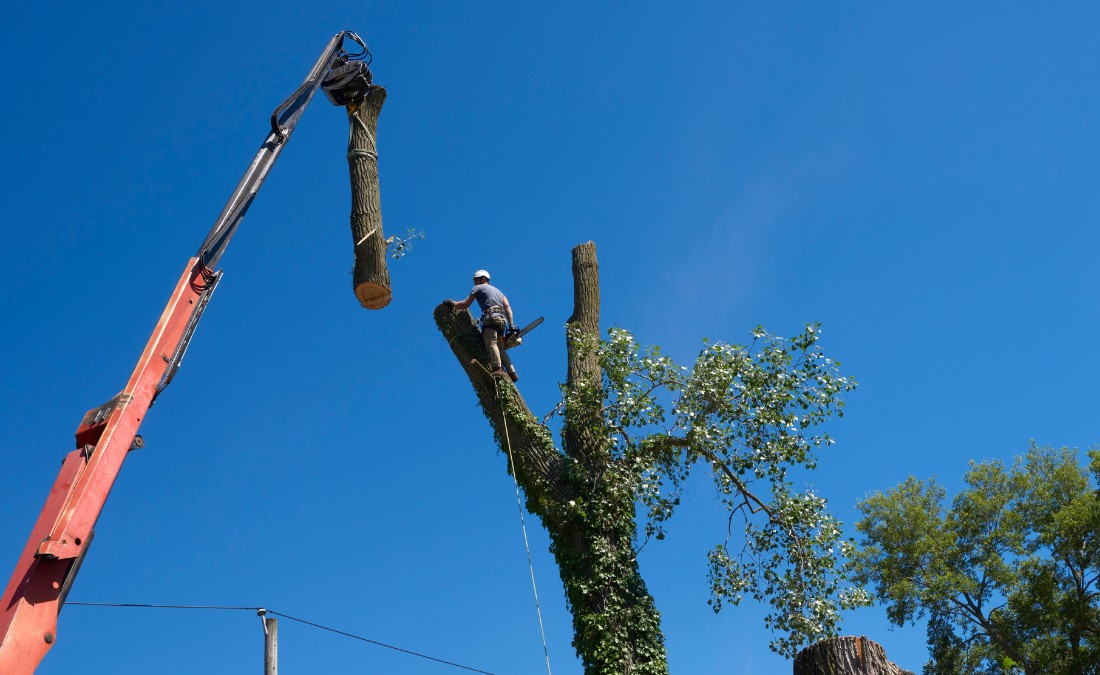
Not every tree requires a crane. Many trees, especially those in open yards with clear drop zones, can be removed using standard techniques like climbing, cutting, and rigging.
But when a tree presents too much risk, size, or inaccessibility, crane-assisted removal becomes the only safe and practical solution.
Let’s break down the exact scenarios where a crane becomes essential — especially in suburban or hilly regions of New Jersey like Warren and Hunterdon Counties.
1. Oversized or Overgrown Trees
When a tree towers above 60 or 70 feet — or has a trunk that’s too wide for a standard notch cut — it poses major safety issues. These giants often weigh several tons and can’t be felled safely in one piece.
Common risks with large trees:
Dropping limbs could crush roofs, cars, or nearby landscaping.
Rigging these trees without mechanical assistance places extreme strain on ropes, anchors, and the climber’s gear.
Climbing high into a dead or brittle tree becomes a life-threatening risk for even the most experienced arborist.
Crane Solution:
A crane allows crews to dismantle the tree in controlled, pre-rigged sections. Each cut section is securely lifted out of the air and lowered gently—no dangerous free-falls or swinging limbs.
2. Confined Spaces (Tight Yards, Back Alleys, or Courtyards)
Some NJ homes, especially in older or more urbanized neighborhoods like Clinton, Flemington, or Washington, have little to no open space around trees. You might find a massive sycamore growing just three feet from your fence—or worse, in the tiny gap between two houses.
Challenges of tight access:
Crews can’t set up ladders or fall zones.
Limbs can’t be dropped without hitting a structure.
Dragging branches out damages lawns, walkways, and flower beds.
Crane Solution:
With a boom arm that extends over rooftops, the crane reaches the tree from the street or driveway—even if there’s no direct yard access. Trees can be removed vertically with zero ground impact.
3. Leaning or Storm-Damaged Trees
Storms can create sudden, dangerous tree hazards—split trunks, cracked branches, or trees leaning at unnatural angles. A partially uprooted tree may look stable but could collapse with the slightest vibration.
Why this is high-risk:
Climbing a structurally unsound tree could cause it to break under the climber’s weight.
Ropes may not hold in decayed wood or splintered limbs.
Traditional felling is unpredictable when a tree’s weight is off-balance.
Crane Solution:
A crane eliminates the need to climb. Arborists can stabilize the tree from above, rig secure lift points, and begin sectional disassembly while staying at a safe distance.
4. Trees Near Obstacles: Power Lines, Garages, Pools
One of the most common reasons for crane use is the presence of structures or utilities near the tree. Even small trees can pose massive liability risks if located near:
Overhead electrical wires
Sheds or garages
Pools or patios
Fences, solar panels, or septic systems
Why this is a problem:
There’s no margin for error. A single miscalculated limb drop can result in expensive damage or life-threatening injury.
Power line interference requires utility coordination, and many cities prohibit felling near live lines without specialized equipment.
Crane Solution:
Crane-assisted removal lifts sections straight up and away, completely avoiding obstacles. It allows the crew to “disassemble” the tree mid-air with exact control over each section’s movement.
5. Hilly or Uneven Terrain
New Jersey’s rolling hills and woodland properties—especially in Warren and Hunterdon Counties—present terrain challenges that can block trucks or prevent standard rigging.
Terrain-related issues:
Equipment like bucket trucks can’t stabilize on uneven ground.
Trees on slopes often lean downhill, increasing fall risk.
Root systems in eroded soil are more likely to collapse under load.
Crane Solution:
Using extended outriggers and leveling systems, cranes can be set up even on challenging slopes. The boom can then reach across uneven terrain or ravines, lifting the tree to a safe staging area.
Benefits of Using a Crane for Tree Removal
Safety First
Crane tree removal avoids dangerous rigging and climbing. Arborists stay out of harm’s way, and your property stays protected.
Faster Jobs
A removal that might take two days by hand can often be done in a few hours with a crane. That’s less noise, less disruption, and less labor.
Less Damage to Yard
With no dragging of heavy limbs across your lawn or flower beds, your yard stays in better shape. Cranes lift the wood up and over.
More Control
A skilled crane operator and arborist work in sync. Every cut is measured. Every lift is planned. It’s not just tree work—it’s tree choreography.
Common NJ Scenarios Where a Crane Is a Must
A 75-foot tulip poplar leaning toward a garage in Washington, NJ.
A rotting ash tree in a fenced-in suburban backyard in Clinton.
A pine tree that fell halfway during a Nor’easter and is tangled in utility wires.
A backyard with no street access except through a narrow driveway.
In these cases, ladders and saws aren’t enough. The crane does the heavy lifting—literally.
Real Case Study: Crane Rescue in Tight Backyard
In early spring, a homeowner in Hunterdon County called about a large oak tree with a split trunk leaning over their pool and pergola. The yard had only a 6-foot gate, and the tree was about 10 feet from the house.
Midstate Tree’s team brought in a boom crane and lifted the trunk sections directly over the roof in under four hours. No damage. No mess. The client said, “I expected days of noise and cleanup—your crew made it look easy.”
Safety Protocols and Certifications
When a crane is involved, tree removal becomes a high-stakes operation. Safety is more than best practice—it’s law.
Certifications That Matter:
ISA Certified Arborists: Ensure tree biology and structural integrity are evaluated properly before cuts are made.
NCCCO-Certified Crane Operators: Know load limits, hydraulic pressure tolerances, and how to manage complex aerial lifts.
ANSI Z133 Compliance: This safety standard governs all aspects of arboricultural operations in the U.S.
Safety Measures in Place:
Pre-Lift Briefings: The entire team reviews roles, emergency plans, and communication protocols.
Rigging Inspections: Slings, pulleys, carabiners, and all gear are checked for wear or weakness.
Weather Monitoring: Wind gusts over 20 mph? The lift is postponed. Safety trumps schedules.
Equipment Checks:
Hydraulic systems are inspected for pressure loss.
Load charts are calculated before each lift.
Emergency release valves and override systems are tested before starting.
This intense attention to detail means fewer accidents, reduced property risk, and higher homeowner confidence—especially in tight, hilly NJ neighborhoods.
Cost Factors of Crane Tree Removal
Crane-assisted removal costs more than standard cutting—but here’s why:
Larger trees mean more labor and equipment.
Crane rental and operator time.
Need for permits (in some towns).
Cleanup, chipping, hauling, and stump grinding.
Most jobs range from $2,000 to $8,000, depending on tree size and access. It’s an investment in avoiding injury, lawsuits, or property damage.
Choosing the Right Crane Tree Removal Company in NJ
Ask the right questions:
Are your arborists ISA-certified?
Do you own your crane or rent it?
Do you have experience working in tight spaces or hills?
Are you licensed and insured for crane work?
Local knowledge matters. A crew that’s worked in places like Harmony, Phillipsburg, or Hackettstown knows the terrain, regulations, and hidden risks.
FAQs
Is crane tree removal only for emergencies?
No. It’s also used for preventive removals before trees fall or become unstable.
Can crane removals be done in winter?
Yes. Frozen ground often helps with access, but snow and ice are safety concerns crews monitor closely.
Is it noisy or damaging to the yard?
Much less so than standard removals. Cranes reduce ground impact and noise by lifting instead of dragging.
Final Thoughts: Smart, Safe Tree Removal Starts with the Right Tools
If your tree removal project matches any of these conditions, it’s not just a job for saws and ropes—it’s a job for precision, planning, and the power of a crane.
Whether you’re in a tight yard in Independence Township, a storm-hit property in Harmony Township, or a wooded hillside in Lebanon Township, crane-assisted tree removal is the smartest and safest way to protect your home, your family, and your landscape.
📍 Serving Warren and Hunterdon Counties? Call your local experts at Midstate Tree for a free quote. We’ve got the crane, the crew, and the care to get the job done right.


